How Knowledge About Trucks Saved My Life
So. You probably saw this dashcam video of a cyclist escaping the wheels of a double tanker truck, while her bike was crushed.
I’ve seen a number of other videos from dashcams or security cams where the outcome was horrific and heartbreaking. Those I would not post. This video is a good teaching tool regarding safety around trucks, because it’s not graphic, and the outcome was good. I posted it on our Facebook page.
Cyclists being crushed by trucks is a recurring tragedy. And it’s one that’s very personal to me.
My point in posting was not to criticize the cyclist. I lament the fact that our culture does not value education enough to ensure that cyclists — really, all road users — understand how to avoid the risks posed by large vehicles.
Cyclists being crushed by trucks is a recurring tragedy. And it’s one that’s very personal to me.
Forget about blame.
It doesn’t matter who’s to blame. We cyclists can keep this from happening to us. This is an empowering revelation, to me. And yet it seems to trigger some cyclists. I want to talk, again, about how to prevent this crash. I also want to talk about how the defensiveness surrounding crash prevention holds us back.
I’m not criticizing the cyclist. I lament that our culture does not value education, and what cyclists need to know to keep themselves safe.
Here’s what I found most fascinating and instructive about discussion on this video — not just on our page, but in other parts of the interwebs as well.
In the video, the cyclist catches up and begins to overtake the truck as it is moving again from being stopped at a red light. For a few seconds, she’s visible to the camera. Then she disappears alongside the truck. Eight seconds later we see her again, as the cab of the truck turns to enter the driveway.
Life or death, in eight seconds.
In those eight seconds, many video watchers “saw” her pass the truck and the truck speed up and overtake her prior to the turn.
Well.
I found the location of the crash on Google maps. Using the measuring tool and the landmarks in the video, I measured the distance the cyclist traveled while she wasn’t visible. It was about 195-200 feet. The truck was a double trailer. Looks like British Columbia regulations allow up to 27.5 meters (90 feet. See Appendix G). Here’s what that looks like on the map (click image to enlarge):
It’s hard to pinpoint the exact location of the cyclist because of her size and distance from the camera, but a reasonably accurate estimated position is possible.
There was not much speed differential between the truck and the cyclist. The length of that truck could have been almost a quarter of the distance she traveled. It is not possible that she passed the truck and it passed her again in the eight seconds she is hidden from view. She caught up to the truck and began passing as it was leaving a stop at a red light. Then it probably matched her speed and she was trapped beside it when it got to the driveway. She may have been in a blind spot — I have no idea what kind of mirrors or cameras the driver had at his disposal.
So what can you do in that situation?
- First, if you know a stopped truck is going to pick up speed again, stay back and do not try to pass it. Never, ever pass near an intersection!
- If you do pass a truck and then find it is pacing you, hit the brakes. Let the truck get ahead of you as quickly as possible.
- If all else fails, do exactly what the cyclist in the video did. Take evasive action, jump off the bike and get away.
Offering these steps to protect yourself in this situation is controversial. Apparently.
This controversy is bigger than safety around trucks.
For some people, it’s unacceptable to say anything other than reassure that the truck driver is guilty and the cyclist is blameless. The truck driver IS responsible for clearing the bike lane before turning. OK? But ALL road users are responsible to use due care to prevent crashes.
Fault is a concept for civil litigation. It’s not a countermeasure.
It’s certainly in the best interest of cyclists to avoid getting squished. But they can’t protect themselves if they don’t know what the risks are.
I get it. Advocates are sensitive — with good reason — to feeling like bicyclists are blamed wrongly for crashes. Pay attention to cycling news and you’ll soon hear stories about the miscarriage of justice.
The most egregious has a name and acronym: Single Witness Suicide Swerve, or SWSS. That’s when an overtaking motorist kills a cyclist, and then claims the cyclist swerved in front of him.
Dwelling on injustice is so intoxicating that entire websites are devoted to cyclist victimology. They get a ton more traffic than sites that promote education and empowerment.
Yes, we must address traffic justice.
I’ve written about it myself. But today and tomorrow — and for the foreseeable future — individual cyclists don’t benefit from outrage and finger-pointing. We benefit from knowing how to avoid becoming victims.
Individual cyclists don’t benefit from outrage and finger-pointing. We benefit from knowing how to avoid becoming victims.
We have exactly zero control over what a truck driver can see, or how well he scans his mirrors. What we do have control over is not putting ourselves in compromising positions.
But in order to have that control, first you need to have the knowledge. You have to be aware of the danger area and understand the risk. We as a culture — and specifically as advocates — have a responsibility to teach ALL cyclists that.
We can argue all day long
that the driver should have scanned more vigilantly before crossing the bike lane.
He had been stopped at an intersection that was 200 feet from his turn. There was plenty of time for a cyclist to catch up and begin to pass the rig. When operating around bike lanes, truck drivers need to be aware of this as much as cyclists do.
But I can only imagine the horror that driver felt when he got out of the rig and saw the crushed bicycle. What might have happened is likely to haunt him. It would certainly keep me up at night. Hopefully, it will make him much more vigilant in the future.
Anyone who has driven a truck knows that workload is high in the cab of a large vehicle. There are more things to pay attention to than what might be coming up from behind.
No one is infallible.
Our system works because we compensate for each other’s mistakes.
Knowledge saved my life. That’s why I’ve dedicated my life to sharing it.
We do it all the time. A couple of weeks ago, I avoided being T-boned by a red light runner, because I looked left before I entered the intersection when my light turned green.
Other drivers have certainly prevented crashes by compensating when I screwed up. I’ve had a few close calls that would have been totally my fault. I’m grateful the other guy was sharp and quick.
This cyclist compensated, too. She made an evasive maneuver and managed to get off her bike and away from the rig. She must have been very shaken. It was a much closer call than my tractor trailer experience — which I’m getting to, I promise.
Let’s save some lives.
My wish is for bike advocates to get beyond the kneejerk need to blame or defend.
There’s no good to come from “othering” truck drivers, either. Making a mistake that kills someone is horrible. It causes massive psychological damage. It pains me to read comments demonizing the truck driver. He’s a person, too.
If we want to save lives, let’s ask: What can we learn from this? What can we teach other bicyclists — and our children — so they don’t become victims of their own, or someone else’s, mistakes.
The majority of the time we spend on the crash-avoidance section of CyclingSavvy is on avoiding the consequences of other people’s mistakes. We don’t focus on blame. We simply recognize the immutable reality that humans make mistakes.
With motorists, those mistakes are amazingly predictable. You can get hung up on being mad about that. I prefer to be grateful. Predictable mistakes are so much easier to avoid! No amount of chest-thumping or demanding justice is going to make people stop screwing up (that includes you and me).
Years ago, motorist errors plagued my existence.
I complained constantly. I insisted there had to be a way to change their behavior, and generated a lot of negative energy around it.
Then one day, in my perennial search for how to fix motorists, I happened upon some educational content for cyclists. It told me ways that I could change my behavior. I wasn’t looking to change my behavior, darn it! I honestly didn’t think it would work, but I tried it. It not only worked, it changed my world and my worldview.
The motorists didn’t change. They still make mistakes.
The difference is, I’m very rarely in a position to be affected by those mistakes anymore.
Now I’m going to tell you why I’m still alive.
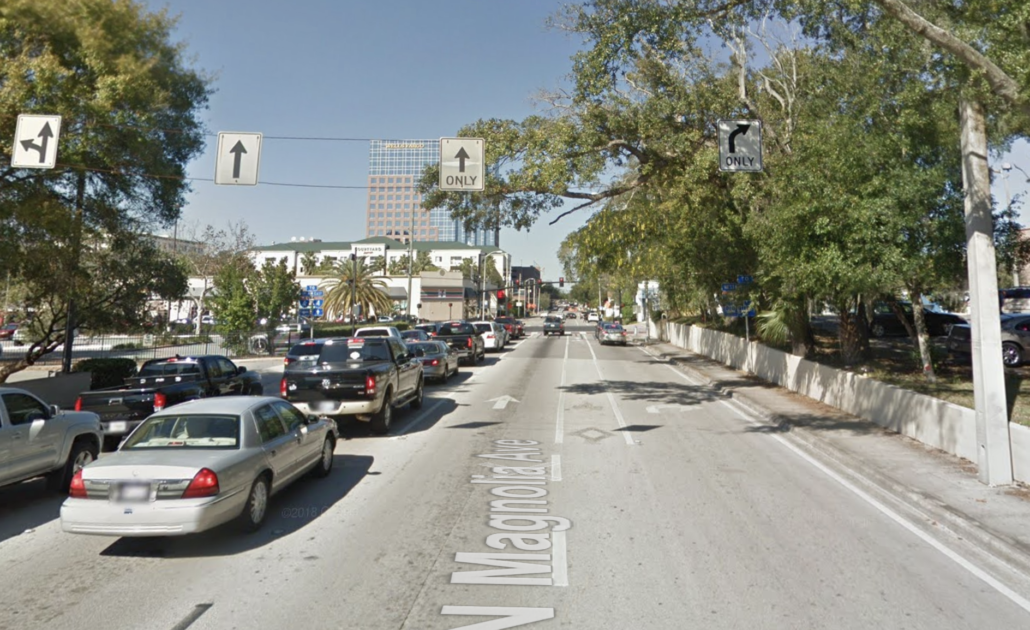
I might have died here.
Eleven years ago, I was riding north on Magnolia Avenue through downtown Orlando. I was in the bike lane. I had turned onto the street a few blocks before the big intersection at Colonial. A block before Colonial, I caught up to a slow-moving truck in the right lane. I slowed and hung back.
I knew about blind spots and wide turns. I’d been exposed to it in the Motorcycle Safety Foundation course, and then more intimately, when I illustrated the Driving Survival Guide for AAA.
As we approached Colonial, the light was red. The bike lane continues to the intersection to the left of the right-turn-only lane. The truck remained in the lane to the left of the bike lane, slowing to stop at the intersection. There was no indication or expectation that truck would turn right on Colonial.
But I have a very strong aversion to riding alongside a truck. I know how wide they turn. I’ve seen them turn right from a left lane. I refuse to take a chance, no matter how remote.
I left the bike lane and pulled into the left-tire track of the thru-lane, to stop behind the truck.
Just as the truck reached the Colonial intersection, the light turned green. At that moment, the driver turned on his right-turn signal and began to turn right.
He turned across the bike lane and the right-turn-only lane.
The truck driver was as wrong as he could be.
He didn’t signal until the last second and he turned from a thru lane with no warning (there is an approach setup for this type of turn). He may have checked his mirror for cars in the turn lane, but he probably would not have seen me.
If I had been there, I would have been caught by surprise, and in all likelihood, killed.
I passed the trailer on the left as it completed the turn. I recognized what would have happened had I made a different decision… if I had not known what I did. I wondered how many other cyclists would have made the same decision.
What never occurred to me was to be angry with the truck driver. Maybe I was too busy being grateful (and pleased with myself).
 Knowledge saved my life.
Knowledge saved my life.
This was a pivotal moment. That’s why I’ve dedicated my life to sharing the knowledge that saved it.
I’ve been working on this program for almost ten years now. In that time, I’ve seen too many heartbreaking stories about cyclists this information did not reach in time.
Will you help save lives?
The video below is an excerpt from our online course. You can also link to it here, or on our facebook page. There is also a web infographic of the poster on the right. The button below will download a PDF of the poster for you to print and distribute.
I’d be so grateful to you if you’d share this message.
Thank you for reading and being part of our mission.

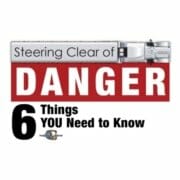

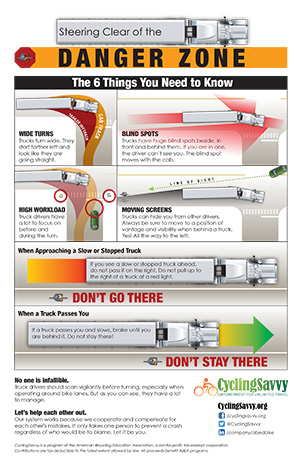
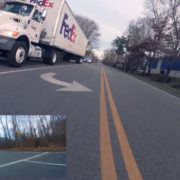
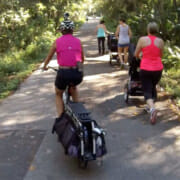

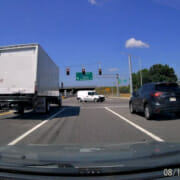
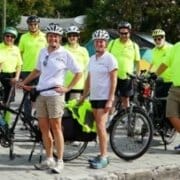



Very good article. Bicyclists have to accept that motorists can and will make mistakes. (As do bicyclists – I have made some mistakes myself as a bicyclist that could have had a very bad outcome under different circumstances.) Instead of blaming the motorist ever time they do something wrong (as the truck driver did in this video), bicyclists should just learn to ride defensively. In this case, as you stated, the bicyclist should not have been riding for any length of time in a potential blind spot of a large truck. Every time I find myself in a similar situation I either slow down to let the truck or bus get well ahead of me, or if necessary I will pull over and stop completely (on the side of the road or the sidewalk) for a couple of minutes until the potential conflict danger is gone.
Great post and illustration.
Yes, we all make mistakes. So we need to learn from our own mistakes and compensate for the mistakes of others so the longer we ride the safer we become.
It’s not just trucks. All vehicles should be treated as if they are going to make a right turn at an intersection or driveway. Any vehicle passing a cyclist or ahead of a cyclist has to be assumed to make a right turn at an intersection or other road entry. The biggest clue is the speed of the vehicle slows down. You can’t rely on turn signals. Also the larger the vehicle the bigger the blind spot, but all vehicles have blind spots. If a vehicle passes you and makes a sudden turn, not much you can do if you are not aware.
Safest way to ride is to avoid busy streets as much as possible even if takes longer.
The advice that bicyclists should drive defensively to avoid becoming victims by compensating for the mistakes of other drivers reminds me of this chart I recently put together with Serge Isaakov. Savvy (defensive & lawful) bicyclists are in Column 1 where the collisions with motorists range from almost impossible to very unlikely.
https://photos.app.goo.gl/X2pqSSpVG7FjtzTh7